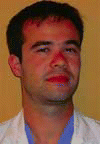ORLANDO, FL-Just how much of the nose plays a role in sleep-disordered breathing should probably get a bit more attention. A new study suggests that there may be such a thing as sleep-disordered nasal breathing, and that nasal congestion significantly worsens during the rapid eye movement (REM) stages of sleep.
Explore This Issue
August 2008Whether the nasal airway causes sleep-disordered breathing is somewhat controversial and not really perfectly characterized, but we do believe that in some or many patients, the nose does contribute to sleep-disordered breathing, said Luc G.T. Morris, MD, an otolaryngologist at the New York University School of Medicine, at an ARS session.
 Whether the nasal airway causes sleep-disordered breathing is somewhat controversial and not really perfectly characterized, but we do believe that in some or many patients that the nose does contribute to sleep-disordered breathing.
Whether the nasal airway causes sleep-disordered breathing is somewhat controversial and not really perfectly characterized, but we do believe that in some or many patients that the nose does contribute to sleep-disordered breathing.-Luc G.T. Morris, MD
Studies in the medical literature show that sleep stage is important to sleep-disordered breathing-most obstruction events occur during REM sleep. But the relationship between REM and what happens in the upper airway is not completely clear, he said.
It has been assumed that sleep-disordered breathing is partly due to REM muscle hypertonia, he said. The explanation is that during REM sleep, all the muscles in the body become partially paralyzed, and we sort of assumed that this would lead the pharyngeal airway dilator muscles to become weak and collapse.…The problem with that theory is that there is really no experimental evidence for it, Dr. Morris said.
He and his research team, which included two sleep specialists, wondered whether anything happened in the nasal airway during REM sleep that could contribute to sleep apnea events. To investigate this, a study was performed with 10 healthy, nonapneic volunteers. They underwent sleep studies at a university sleep lab and had overnight polysomnography, as well as acoustic rhinometry, while they slept.
Acoustic rhinometry was also performed before the subjects went to sleep and while they were in a sitting position. Another set of measurements was also attained while the subjects lay down for 15 minutes, but were still awake. After the subjects were asleep, two sets of measurements were done during two separate REM stages, as well as during two non-REM stages. In the morning after awakening, the subjects were decongested and morning baseline measurements were attained.
When patients were awake and seated prior to sleep, the mean congestion factor (MCF) of the nasal airway was 10.6%. In the supine position this increased to 16.2%. MCF was at its highest-22.3%-during REM. During non-REM sleep, MCF was at its lowest, at 2.3%. The differences were statistically significant.
Leave a Reply